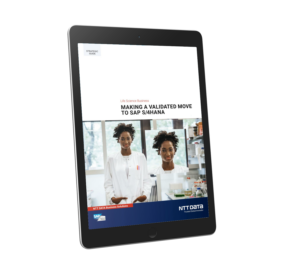Three Ways to Move to SAP S/4HANA: Greenfield, Brownfield & Hybrid

A Guide for Organizations in Life Sciences
Choosing which ERP to implement is a big decision, however the process of conversion can be just as difficult. Software implementations require the cooperation of multiple departments, significant resources are required to train users, systems need to be tested, business units often face downtime, and huge reserves of data may need to be compiled and transferred. What’s more, life sciences companies are subject to strict regulations to ensure the validated state. With all these considerations, it’s easy to see why many businesses put off software upgrades or new implementations until they have no other option. However, by choosing the right approach many of these challenges can be greatly minimized.
Whether you’re planning to move to SAP S/4HANA, or another enterprise platform, there are three categories: Greenfield, Brownfield and Hybrid. In this post we explain the difference between each to help your team make the best decision for your organization.
The Greenfield Implementation
The greenfield approach is a completely new implementation, allowing you to design systems and workflows from scratch. The greenfield approach would automatically apply if your organization doesn’t currently run a SAP ERP (such as ECC 6.0), however organizations that are already on SAP can also choose this route. It provides the impetus to leave outdated processes and inconsistent data behind and design brand new processes. For this reason, greenfield transitions are often combined with a shift to a new organizational structure or a change to the business model.
While the system may be entirely new, data does not have to be completely left behind in a greenfield transition. It’s possible to migrate data from the old system, and if it doesn’t suit your business to cut across on a certain date, both the old and new systems can operate in parallel during a transition period.
The Benefits of Greenfield Transitions with us
Greenfield transitions can also be made easier by using templated functionality. For example, NTT DATA Business Solutions has implemented SAP software for many organizations in the life sciences industry, so over the years we have built a library of common processes, based on best practices in the life sciences industry. This solution is called it.lifesciences. Our clients are presented with processes that can be essentially copied and pasted into their setup. By re-using our industry specific enhancements, development hours can be reduced significantly.
In addition to our life sciences best practices, our solution is fully documented, ranging from URS to test scripts, it’s also supported by a proven industry-specific project methodology that integrates validation with standard ERP project management. Our clients can rely on the support of highly skilled consultants, in-house validation officers, as well as the reliability of standardized SAP tools and techniques.
The Hybrid Implementation
Also known as selective data transition or landscape transformation, the hybrid approach allows you to consolidate several ERP systems into one. For those running an international business with several legacy systems, or who have recently acquired a new company, this can be an efficient way to combine data from multiple places and reduce their system footprint.
The hybrid implementation allows companies to customize their existing ERP to make use of the many innovations available in SAP S/4HANA.
The Benefits of a Hybrid Transition with NTT DATA Business Solutions
As with a greenfield transition, a hybrid transition to SAP S/4HANA with NTT DATA Business Solutions provides the option to move in parallel to your daily business. This approach gives a flexibility/opportunity to modify the current landscape. It can be either consolidation of multiple clients (with business process harmonization) OR it can also be leveraged to migrate the business in parts.
The Brownfield Implementation
Some life sciences organizations find they have spent many years shaping the perfect IT landscape, so they would prefer to change only what is necessary in order not harm validated processes.
A brownfield software transition allows you to keep all of your existing structure and processes, while the upgrade occurs on the backend. Additional functionality can also be added. This is perhaps the most common approach for upgrading to SAP S/4HANA.
Why undertake a Brownfield transition with us
If you are currently using a SAP ERP, NTT DATA Business Solutions can upgrade it to SAP S/4HANA on a fixed schedule and budget. Using our methodology also ensures the validated state of your current system. Finally, in order to make our system conversions as efficient and smooth as possible, we’ve developed and established what we call our Conversion Factory, which is a team of conversion specialists certified by SAP.
Transition paths to SAP S/4HANA

Why Move Now?
Regardless of which option you choose, acting sooner provides immense benefit. The earlier a conversion is made, the more time you have to gain an advantage over your competitors. Limited support lifespans should be taken into account too. SAP support for ECC 6.0 is scheduled to end in 2027, which might seem like a long time away, however a complete conversion process can be complex, and skilled software engineers are often difficult to recruit toward the end of a product’s life.
Learn More in the White Paper

Our white paper ‘Making a Validated Move to SAP S/4HANA’ is a more detailed transition guide, written exclusively for life sciences professionals.